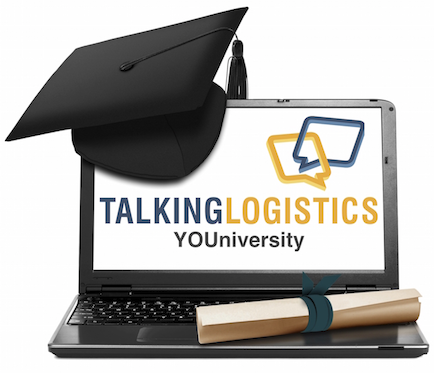 Before diving into this week’s supply chain and logistics news, I want to share a couple of quick news items of our own.
Before diving into this week’s supply chain and logistics news, I want to share a couple of quick news items of our own.
First, for all of you who have asked for podcast versions of our Talking Logistics episodes, they are now available on our iTunes Podcast channel! We have 40 episodes uploaded and all future episodes will be uploaded automatically shortly after airing. You can also download the .MP3 file for each episode directly from its Talking Logistics page.
 Second, we just released our second Talking Logistics YOUniversity course, Building a Strong Transportation Management Foundation. This self-service 4-session course provides an overview of how to build a strong transportation management foundation, with a focus on strategy development, procurement, the role of technology, and the importance of enabling a continuous improvement culture and processes. The course was assembled from past Talking Logistics episodes related to the topic featuring experts from LeanLogistics (a Talking Logistics sponsor), coupled with blog posts and other value-added content to enhance the overall learning experience. We also developed a short online quiz for you to take after completing the course, and enabled an online discussion forum for course participants to post questions and share knowledge and advice with each other. I encourage you to check out the course and let us know what you think.
Second, we just released our second Talking Logistics YOUniversity course, Building a Strong Transportation Management Foundation. This self-service 4-session course provides an overview of how to build a strong transportation management foundation, with a focus on strategy development, procurement, the role of technology, and the importance of enabling a continuous improvement culture and processes. The course was assembled from past Talking Logistics episodes related to the topic featuring experts from LeanLogistics (a Talking Logistics sponsor), coupled with blog posts and other value-added content to enhance the overall learning experience. We also developed a short online quiz for you to take after completing the course, and enabled an online discussion forum for course participants to post questions and share knowledge and advice with each other. I encourage you to check out the course and let us know what you think.
Now, here’s the rest of this week’s news…
- Target to invest billions to improve supply chain, ramp up online growth (Reuters)
- GameStop expects fewer price markdowns with ship from store service (Dallas Business Journal)
- Google says it bears ‘some responsibility’ after self-driving car hit bus (Reuters)
- E2open Acquires Terra Technology
- LeanLogistics Offers Software Solution LeanGlobal to Ocean Shippers
- Descartes Reports Fiscal 2016 Fourth Quarter and Annual Financial Results
- JDA Achieves Key Competitive Wins and Sees Strong Cloud Growth
- MNX Global Logistics Acquires Specialty Aviation 3PL Aero Express Logistics in Singapore
- DOT Releases 30-Year Freight Projections
- U.S. regulators seek more input on truck fuel efficiency rules (Reuters)
Traditional distribution networks and processes were built around yesterday’s consumer — who shopped almost exclusively at stores and malls, and who didn’t mind waiting 3-5 days for delivery — but new distribution networks and processes are emerging for a new generation of consumers, who will shop more online (especially on mobile devices) and expect same-day shipping and delivery, or click-and-collect within an hour, as a standard offering.
For traditional brick-and-mortar retailers, making this transformation will require a lot of effort and money, as this week’s news from Target demonstrates. As reported by Reuters, the company will invest “$2-$2.5 billion annually starting 2017, mainly to upgrade its supply chain and technology infrastructure, as it races to reduce stock shortages and pushes for online growth.” The Wall Street Journal also reported on this story:
Target is racing to modernize its supply chain operations to handle all these jobs as it addresses problems that cropped up during the transition. In recent quarters, Target has struggled with inventory shortfalls as it tried to cater to online and in-store shoppers at the same time.
“The systems were built to continue to replenish as a normal store,” Target Chief Executive Brian Cornell said recently. “Now, we’re shipping from stores. Now, we’re trying to localize items. It has added greater complexity.”
This is all music to the ears of supply chain and logistics software vendors, as well as third-party logistics providers, who can position themselves to assist retailers with this transformation. As always, the biggest hurdle to overcome will be change management — not only with regards to transforming internal processes, but also in changing the way retailers work with suppliers and other external partners. As I discussed recently with Doug Kimball from JDA Software, omni-channel is also having a significant impact on manufacturers and their supply chain and logistics processes.
Moving on to technology news, hot off the presses this morning, E2open announced that it has acquired Terra Technology, a provider of “Demand Sensing, Multi-Echelon Inventory Optimization, and Transportation Forecasting solutions which incorporate data from the extended supply chain (like point of sale and logistics data) and advanced algorithms to radically improve supply chain performance.” Some of Terra Technology’s customers include Procter & Gamble, Unilever, Mondelēz International, Kimberly-Clark, ConAgra Foods, Kellogg, AkzoNobel and Shell. Here’s a comment from E2open CEO Michael Farlekas:
“We’re thrilled to have Terra Technology join us. Terra’s Demand Sensing capabilities allow companies to combine massive amounts of data from the supply chain to leverage demand signals which dramatically improve forecast accuracy. E2open brings the network to connect, collect, and collaborate on these demand signals in real-time across the multi-enterprise supply chain. Our combination will allow deep information access and collaboration across the extended supply chain to sense demand changes, and react quickly to address supply constraints, optimize inventory, and improve in stock ratios.”
Transportation Forecasting — which basically takes demand forecasting, promotions, point of sale data, and other demand signals to create a forecast of transportation requirements — is one of those ‘white spaces’ in transportation management systems. As I discussed in a May 2013 Talking Logistics episode, Revisiting Transportation Forecasting, there are many benefits to transportation forecasting, but also some “change management” hurdles to overcome.
I haven’t had a chance to speak with E2open yet about this acquisition, but I see it as another example of how the solution footprint of Supply Chain Operating Networks continues to expand, especially into the collaborative planning realm.
In other technology news, LeanLogistics introduced LeanGlobal® this week, a new TMS module that enables “clients to plan and book full container load (FCL) ocean moves directly with the vessel carriers and freight forwarders, provide full visibility of FCLs from pickup to delivery, and ensure compliance with international trade laws—all on one platform with domestic transportation.” Here are some additional details from the press release:
LeanGlobal clients can leverage the drayage management system to automate the creation of drayage loads that are synchronized with the associated ocean booking. Through direct connectivity with U.S. government systems, the necessary import and export security filings for international shipping are auto-populated, based on the data within the TMS, and electronically filed.
Another feature of LeanGlobal is the utilization of WebSettle® for ocean freight audit and settlement. WebSettle manages accruals, freight invoice, discrepancy checking, and freight cost allocation to avoid inaccuracies and delays.
I was given a demo of the solution a couple of weeks ago and what struck me the most was the user interface and the seamless nature of the workflow. The company also shared with me a couple of customer case studies of early adopters and the benefits they have achieved to date. In short, considering that many of Lean’s existing clients ship via ocean and that demand for TMS solutions with ocean shipping capabilities is growing, this is an important and timely release for LeanLogistics. I look forward to learning more about the solution and how customers are using it when I attend Lean’s user conference next month.
Finally, both Descartes and JDA Software highlighted their strong momentum heading into 2016. Descartes reported record revenues of $185.0 million for FY16, which ended on January 31, 2016 — up 8 percent from FY15. Earnings per share on a diluted basis was $0.27, up 29 percent from $0.21 in FY15. Meanwhile, JDA announced that it signed 127 net-new customers in 2015 and saw tremendous growth in its workforce, warehouse and transportation management solutions. The company also reported that its JDA’s Cloud business has now grown to be over $100 million in revenue, and in total, JDA now has more than two million cloud users across 350 customers.
The sun continues to shine in the supply chain software space.
And with that, have a happy weekend!
Song of the Week: “Rebellion (Lies)” by Arcade Fire
Note: Descartes, JDA Software, and LeanLogistics are Talking Logistics sponsors.









